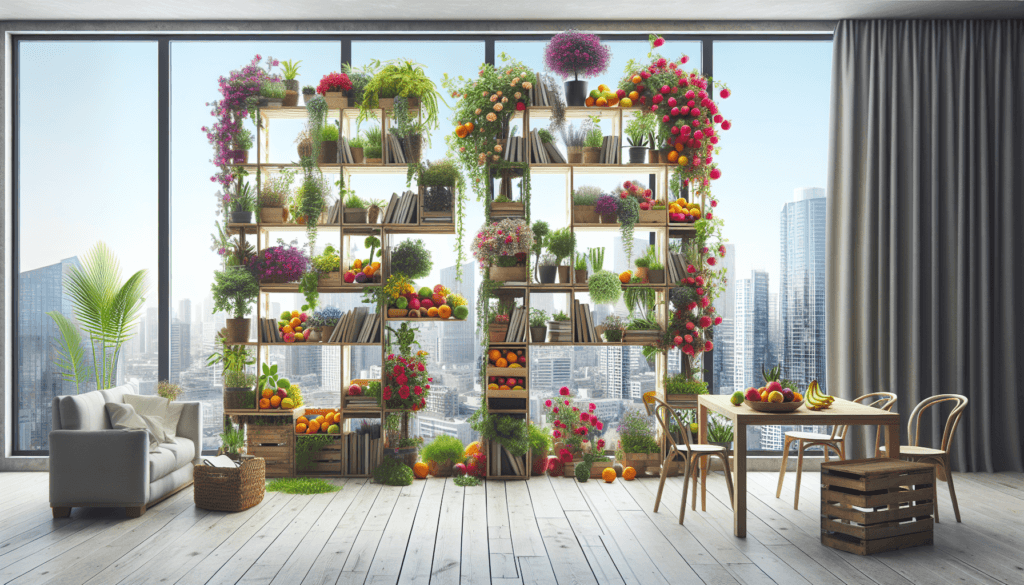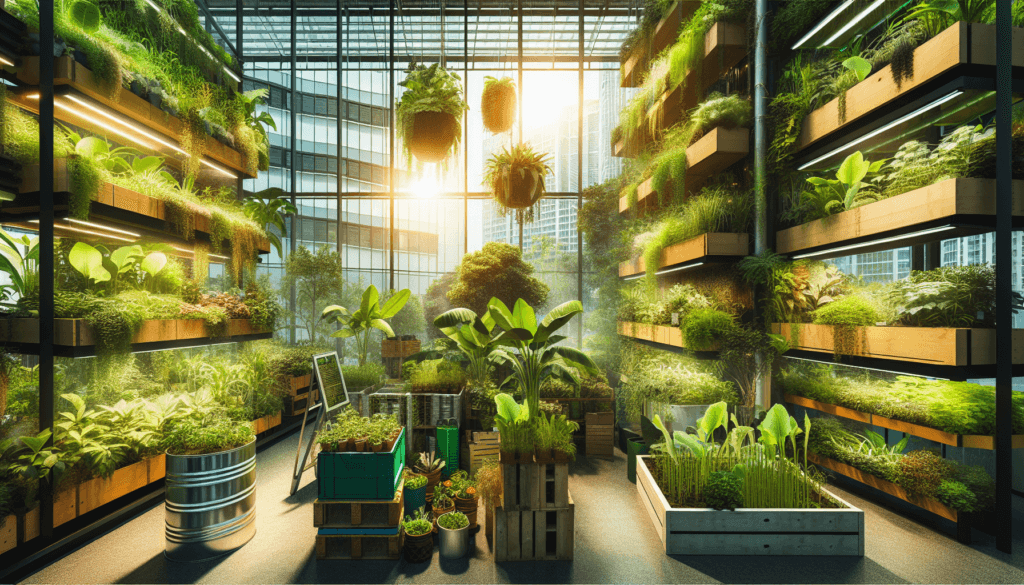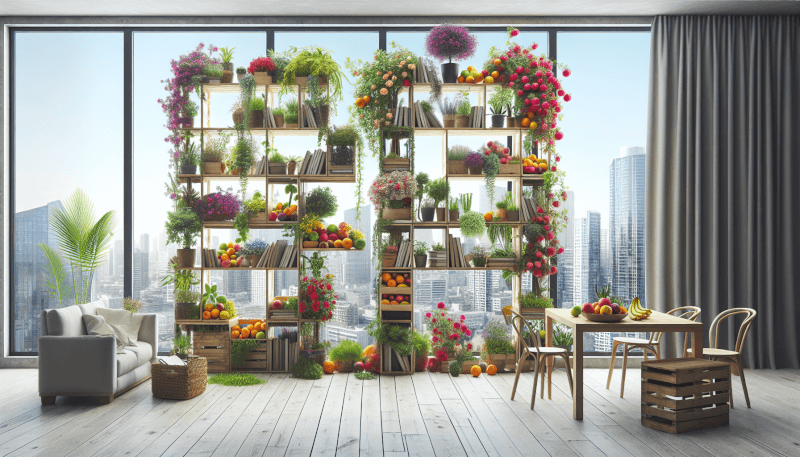Imagine having your own thriving garden, filled with lush plants and vibrant flowers, right in the heart of the city. It may seem impossible, but with a little creativity and some clever techniques, you can grow a successful urban garden even without outdoor space. Whether you live in a tiny apartment or a high-rise building, this article will guide you through the steps to create your own green oasis indoors. Discover how to choose the right plants, optimize natural light, and maximize your limited space to cultivate a flourishing urban garden that will leave your friends green with envy.

Choosing the Right Location
Finding the right location is essential when it comes to growing a successful urban garden without outdoor space. Assessing available space is the first step in determining where to set up your garden. Look for areas in your home that have ample room for containers or shelves to hold your plants. Consider using windowsills, countertops, or even vertical wall space for your garden.
In addition to available space, sunlight exposure is another crucial factor to consider. Most plants require at least six hours of direct sunlight each day to thrive. Take note of the areas in your home that receive the most sunlight throughout the day and plan to place your plants there. South-facing windows tend to provide the most sunlight, while north-facing windows may provide less direct sunlight.
The next consideration is evaluating ventilation options for your indoor garden. Good air circulation is important for preventing issues such as mold and mildew, as well as promoting healthy growth for your plants. Make sure your chosen location has access to fresh air or consider using fans to increase airflow. Proper ventilation will help your plants thrive and prevent stagnant air from causing problems in your indoor garden.
Selecting Suitable Containers
Once you have determined the location for your urban garden, it’s time to select suitable containers for your plants. Determining container size is crucial to ensure your plants have enough space to grow and develop a strong root system. Research the mature size of the plants you intend to grow and choose containers that will accommodate their growth.
While considering container options, opting for lightweight and portable options can make it easier to move your plants around if necessary. This is especially beneficial if you have limited space or if your plants require varying sunlight exposure throughout the day. Containers made of materials like plastic or fabric are often lightweight and easy to transport.
Proper drainage is another important factor to consider when selecting containers. Ensure that the containers you choose have drainage holes to prevent water from pooling at the bottom, which can lead to root rot and other issues. If your containers do not have drainage holes, consider adding a layer of gravel or perlite at the bottom to improve drainage.

Choosing the Right Plants
Choosing the right plants is essential for a successful indoor garden. Researching plant requirements is the first step in selecting suitable plants. Different plants have different needs, such as light requirements, temperature preferences, and humidity levels. Understanding these requirements will help you make informed decisions when selecting plants for your indoor garden.
When gardening indoors, it’s important to choose plants that thrive in indoor conditions. Some plants are better suited for indoor environments due to their ability to tolerate lower light levels and adapt to the controlled climate. Examples of plants that thrive indoors include herbs like basil and mint, leafy greens like spinach and lettuce, and flowering plants like African violets and orchids.
Consider companion planting when choosing plants for your indoor garden. Companion planting involves growing different plants together that benefit each other in some way. For example, pairing herbs like rosemary with vegetables like tomatoes can help repel pests and improve overall plant health. Research companion planting combinations to maximize the success of your indoor garden.
Providing Adequate Lighting
Proper lighting is crucial for the success of your indoor garden. Understanding the importance of lighting and its impact on plant growth is the first step. Plants need light to photosynthesize and produce energy for growth. Without sufficient light, plants may become weak and leggy, or fail to grow altogether.
Choosing the right type of grow lights is essential for providing adequate lighting to your indoor garden. LED grow lights are a popular choice for indoor gardening due to their energy efficiency and ability to provide a spectrum of light that plants require for photosynthesis. Alternatively, fluorescent grow lights can also be used, especially for lower light requirement plants.
Creating a lighting schedule is important to ensure your plants receive the appropriate amount of light. Most plants require at least 12-16 hours of light per day, simulating a typical day-night cycle. Setting a timer for your grow lights will help maintain a consistent lighting schedule and promote healthy growth for your indoor plants.

Ensuring Proper Watering and Drainage
Proper watering and drainage are essential for the health of your indoor garden. Determining the watering needs of your plants is the first step. Different plants have different water requirements, so it’s important to research the needs of each plant in your indoor garden. Overwatering or underwatering can lead to root rot or dehydration, respectively.
Investing in a watering system can make the task of watering your plants more manageable. Options include self-watering containers, drip irrigation systems, or even using a simple watering can with a narrow spout for precise watering. Choose a watering system that suits the needs of your indoor garden and allows for proper hydration without causing excess moisture.
Monitoring soil moisture levels is important to ensure your plants receive adequate water. You can use a moisture meter or simply stick your finger into the soil to check for moisture. It’s important to water your plants when the top inch of soil feels dry to the touch. This will help prevent overwatering or underwatering and ensure your plants receive the right amount of hydration.
Fertilizing and Nutrient Management
Proper fertilizing and nutrient management are essential for the overall health and productivity of your indoor garden. Understanding plant nutrient requirements is the first step. Plants require essential nutrients such as nitrogen, phosphorus, and potassium, in addition to secondary and micronutrients. Research the specific nutrient requirements of the plants in your indoor garden and choose an appropriate fertilizer.
Using organic fertilizers is recommended for indoor gardening, as they are gentle and release nutrients slowly over time. Organic fertilizers, such as compost or worm castings, help improve soil fertility and provide a balanced nutrient profile to support plant growth. Avoid using synthetic fertilizers, as they can lead to nutrient imbalances and potential harm to your indoor garden.
Implementing a nutrient management plan will help ensure your plants receive the necessary nutrients. This plan can include a regular fertilizing schedule, monitoring nutrient deficiencies or excesses, and making adjustments as needed. Regularly monitoring and adjusting your nutrient management plan will help maintain a healthy and thriving indoor garden.

Managing Pests and Diseases
Pests and diseases can pose a challenge to indoor gardening, but with proper management, you can keep your plants healthy and pest-free. Identifying common urban garden pests is the first step in managing them. Common pests include aphids, spider mites, mealybugs, and fungus gnats. Research the signs and symptoms of these pests to catch them early and take appropriate action.
Implementing natural pest control methods is recommended for indoor gardening. Avoid using harsh chemicals that can harm beneficial insects or yourself. Options for natural pest control include using neem oil, insecticidal soaps, or introducing beneficial insects such as ladybugs or predatory mites. Regularly inspecting your plants and taking immediate action will help prevent pests from causing extensive damage.
Monitoring plants for signs of disease is important to catch any issues early on. Common diseases in indoor gardens include powdery mildew, root rot, and fungal infections. Regularly inspect your plants for yellowing leaves, mold or mildew growth, or wilting. If any signs of disease are detected, take immediate action by removing affected plant parts, adjusting watering or humidity levels, or applying appropriate treatments.
Maximizing Vertical Space
When growing an urban garden without outdoor space, maximizing vertical space is a smart strategy to increase plant capacity. Utilizing vertical gardening techniques can help you grow more plants in a limited area. This includes using techniques such as hanging baskets, trellises, and wall-mounted planters to create more planting space.
Selecting appropriate trellis and support structures is essential when growing vining vegetables and fruits. These plants require vertical support to grow and climb. Choose sturdy trellises or cages that can support the weight of the plants as they grow. Ensure your chosen support structures are securely anchored to prevent any accidents or damage to your plants.
Growing vining vegetables and fruits is an excellent way to maximize vertical space in your urban garden. Examples of vining vegetables include cucumbers, tomatoes, and beans, while vining fruits include strawberries and grapes. Train these plants to climb up trellises or fences to utilize vertical space effectively and increase your harvest potential.

Utilizing Indoor Microclimates
Identifying microclimates within your home is another strategy to optimize your indoor garden’s success. Microclimates are areas within your home that have slightly different climate conditions, such as temperature, humidity, or air circulation. By identifying these microclimates, you can match plants to suitable conditions and increase their chances of thriving.
Match plants to suitable microclimates based on their specific needs. For example, if you have a bathroom with high humidity levels, it would be an ideal microclimate for plants that thrive in tropical or humid environments. On the other hand, plants that prefer cooler temperatures can be placed near windows or in a cooler room with lower heat levels.
Creating artificial microclimates is another option to optimize your indoor garden. This can be achieved by using humidifiers or dehumidifiers to adjust humidity levels, using fans to improve air circulation, or using heating mats to provide consistent warmth to plants that require higher temperatures. By creating artificial microclimates, you have more control over the conditions your plants are exposed to and can tailor the environment to their specific needs.
Harvesting and Maintaining
Knowing when to harvest is crucial for enjoying the fruits of your labor. Each plant has different maturity times, and it’s important to research and understand the specific harvest times for the plants in your indoor garden. Harvesting too early or too late can impact the taste and quality of your produce.
Proper techniques for harvesting will ensure minimal damage to your plants and encourage regrowth if applicable. Use clean, sharp pruners or scissors to cut fruits, vegetables, or herbs from the plant. Take care not to damage the remaining plant or any nearby growth points. Proper harvesting techniques will promote continued growth and productivity in your indoor garden.
Regular maintenance and plant care are important to keep your indoor garden thriving. This includes tasks such as regularly checking for pests or diseases, removing dead or yellowing leaves, and providing ongoing care such as watering, fertilizing, and adjusting lighting or humidity levels. By staying vigilant and maintaining a regular care routine, you can ensure the long-term success of your urban garden.
In conclusion, growing a successful urban garden without outdoor space is possible with the right approach. By choosing the right location with ample space, appropriate sunlight exposure, and proper ventilation, you can set a solid foundation for your indoor garden. Selecting suitable containers with the right size, lightweight and portable options, and adequate drainage will support healthy plant growth. Choosing the right plants that thrive indoors, researching their requirements, and considering companion planting will maximize the success of your indoor garden. Providing adequate lighting, ensuring proper watering and drainage, implementing a nutrient management plan, managing pests and diseases, maximizing vertical space, utilizing indoor microclimates, and practicing proper harvesting and maintenance techniques will further enhance the productivity and longevity of your urban garden. With commitment, care, and a friendly attitude towards your plants, you can create a flourishing urban oasis right in the comfort of your own home.

